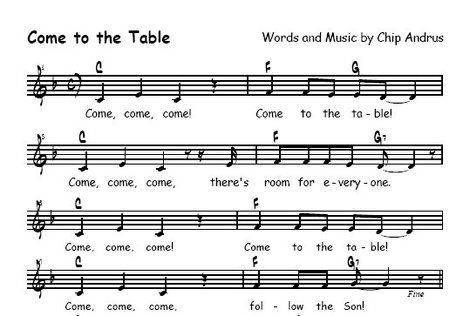Come to the Table
February 11, 2006
 A wonderful way to make explicit the sacramental connection between our everyday life and its distillation in liturgy is to sing a variation on the Great Prayer over our ordinary meals. Chip Andrus, a pastor, teacher, and musician with the Office of Theology and Worship for the PC(USA) has written a lively folk prayer that works well for just this purpose.
A wonderful way to make explicit the sacramental connection between our everyday life and its distillation in liturgy is to sing a variation on the Great Prayer over our ordinary meals. Chip Andrus, a pastor, teacher, and musician with the Office of Theology and Worship for the PC(USA) has written a lively folk prayer that works well for just this purpose.
Sing upbeat, but not too fast—maybe 88 bpm. The song is syncopated throughout, but is notated more simply here for easier learning. Once you’re familiar with it as written, attempt appropriate syncopation where you feel it (the third “come” in the first measure should slightly anticipate the third beat). If you have trouble, ask your kids for help. The song repeats the chorus a few times, and then concludes moving to the tonic and repeating “come.”
This wonderfully percussive tune works best antiphonally. When the meal is almost ready, begin to sing (“Come, come, come!”) as you bring the food from the kitchen to the table. Or send out a family member to the corners of the house, singing and summoning everyone together. When all are assembled, conclude with a spoken prayer to God, since this song is a call to pray and feast rather than a prayer itself.
It’s especially fitting to pray following a classic prayer pattern, like a collect. So, for instance, begin by (1) addressing God and naming one of God’s attributes (“God, you are . . .”); then (2) speak a word of thanks and/or make an appeal rooted in that attribute (“we thank you for/help us to . . .”); finally, (3) express an aspiration rooted in God’s character, an outcome that makes sense of the request (“so that we might . . .”). For example, (1) Lord Jesus, you said that wherever two or three are gathered together, you are with them. (2) We thank you, then, for this good food, for those who made it, for each other, and for your presence with us as we eat. Open our eyes to see you at this table, (3) so that we might more easily see you when we leave it.
(For more table graces for the home, see here.)